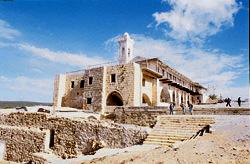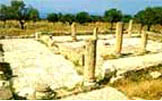 On
the way to Karpas from Famagusta, the largest settlement in
the area is Iskele (Trikomo). The town is mainly inhabited
by the Turkish-Cypriot refugees from Larnaca (now in south
Cyprus) who relocated to here after 1974.
The
quaint 15th century Byzantine church of St. Jacob (Ayios Iakovos)
dominates the center of the town. Iskele icon museum is another
main attraction in the town. Inaugurated in 1991, the 12th
century church of Panagina Theotokos (Blessed Virgin Mary)
is preserved by the Department of Antiquities and Museums as
the icon museum.
HISTORICAL PLACES OF ISKELE
A castle belonging to the town, rock tombs, a temple, and
a harbour which is now full have been found as a result of
excavations carried out in the region. The town was one of
the six important towns of Cyprus in the 2nd century B.C..
There are three churches close to Aphendrika: Saint Georgios,
Panaya Chrysiotissa and Panaya Asomatos. Saint Georgios is
a single-domed church with a two-part apsis built in the
10th century. Panaya Chrysiotissa was constructed in the
6th century. It was renewed at the end of the 10th century
as it had been destroyed as a result of Arab raids. The wooden
ceiling was replaced with a tunnel-vaulted one. The church
was destroyed once again during the middle ages and was reconstructed
for the last time in the 16th century. The one in the best
condition of these three churches is the Panaya Asomatos
church built in the 6th century. This church too was reconstructed
in the 10th century as it was destroyed during the Arab raids.
The main church of the village of Trikomo was built in
XII. century on a single platform and a single dome, the
side walls have indented arches. This type of Cypriot church
can be seen from XII. century onwards. A northern vault
and platform was added to the building in XV. Century,
the additions were added at the later date. The church
was completely resorted in 1804. The modern bell-tower
with engraved marble panels situated in the north-east
corner, was most probably taken from ab original iconanststen
banister. Most of the XII. century wall paintings are presently
being preserved, the paintings were restored in 1966, the
upper parts of the vaults were replastered, the indents
of the southern wall displaying paintings from XII. century
were discovered in November 1967. After the restoration
by there TRNC Department of Antiquities and Museums, the
church was opened after "World Museum Day" an
23rd May 1991 under the tittle of Icon Museum of Iskele.
The Apostolos Andreas Monastery
 The
monastery, situated on the point known as the Cape
of Saint Andrea, is dedicated to Saint Andrew (Apostle
Andreas). Information about the saint whom the monastery
has been named after comes from the holy books. As he was
the first person to be called for induction to priesthood
by Christ, his title was "O Protoklitos" meaning, "the
one first called". The room under the modern church
in which there are wells containing drinking water is thought
to have been a chapel belonging to the old monastery buildings.
On the bust in the courtyard of the monastery the monastery
is stated to have been built by Pope Ionnis Oicoromus.
Both Turks and Greeks consider the monastery a holy place;
it is visited by many people for votive prayers. The contents
of the monastery are also noteworthy.
 The Basilica dates back to the 6th century A.D. Probably because
it was destroyed in mid-7th century, a small church and some
annexes were added to its southern flank. As these buildings
were destroyed in the ninth and tenth centuries A.D., this
settlement was not used any more. The basilica has three sections:
to the west is the exterior, atrium; to the southeast are the
annexes and the baptistery. The floor is covered with mosaics
with motifs of geometric shapes, leaves and crosses. It is
recorded in the inscription on the mosaics that they were made
by Heraclos, one of the assistants of the priest.
 It has been constructed on ruins dating from the Hellenistic
and Roman periods. Philon is the saint who converted the people
of Karpaz to Christianity in the 4th century. The church comprises
a three-part apsis and a courtyard surrounded with columns.
There are colourful mosaics on the floor. A domed church was
built in the 12th century on the ruins of the old building
destroyed by the Arab pirates. It also has a cistern and a
baptising room. The region it is in, is the vicinity of the
town of Karpasia in the Phoenician period.
 The easternmost of the three castles on the Kyrenia mountains,
the Kantara castle, is about 700 metres above sea level
and is well positioned to control the entrance to the
Karpaz peninsula and The Mesaria plain. Although it
is thought to have been constructed by the Byzantines
following the Arab raids on the island like the other
two castles, St. Hilarion and Buffavento, the written
sources only make a mention of the castle in the year
1191, when Richard Lion-Heart captured the island.
When the impostor king of Cyprus Isac Comnen is defeated
by the former Palestine King, Guy de Lusignan, who
submits to Richard Lion-Heart, he takes refuge in this
castle. He gets caught while trying to escape in the Karpaz
region. In the Lusignan and Venetian periods frequent mention
of the castle is made. The castle is involved in many battles
in this period. Although the Genoese conquer Nicosia and
Famagusta in 1373, the castle stays in the hands of the
supporters of the King of Cyprus, Peter I. It is known
that, when the king’s brother, Prince John, escapes
from captivity in the hands of the Genoese, he takes
refuge in the castle. The castle is surrounded with
walls by King James in 1391. After the Venetians gain
control of the island, like other castles away from
the sea, this castle too loses its importance. The
castle has sections like a defence line, dormitories,
a cistern, vaulted rooms, and a signal tower.
|